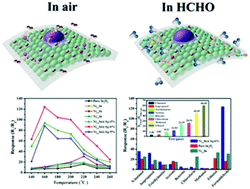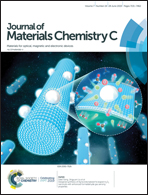Designed synthesis of Ag-functionalized Ni-doped In2O3 nanorods with enhanced formaldehyde gas sensing properties†
Abstract
The reasonable design of semiconductor metal oxides modified by elemental doping and surface functionalization has been proven to be an effective method to improve the gas sensing abilities of chemiresistor-type sensors. In this work, Ni-doped In2O3 nanorods were fabricated via simple oil bath and annealing processes. To further enhance their gas sensing performances, Ag functionalization was carried out by a subsequent chemical reduction process. The experimental results reveal that these composites exhibit excellent formaldehyde sensing performance compared with pure In2O3 nanorods. In particular, 6%-Ag/Ni5.0In presents significantly enhanced gas sensing performance toward 100 ppm formaldehyde gas at a low working temperature (160 °C) with high sensitivity (123.97), fast response speed (1.45 s/58.2 s), and good selectivity and stability. Our research reveals that the improvement in sensing performance toward formaldehyde can be attributed to the large specific surface area, high relative contents of OV and OC components, electronic sensitization and the catalytic effect of Ag. The results provide an effective strategy to achieve excellent gas sensing performance for formaldehyde gas sensors.



 Please wait while we load your content...
Please wait while we load your content...